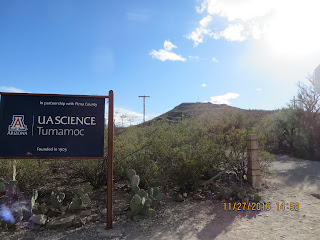Thanksgiving weekend was coming to a close and my YL had a friend over on Sunday afternoon, so I decided it would be a nice opportunity to take a walk up and activate the peak (W7A/AW-057). I parked on the side of Anklam Road, along with plenty of other vehicles. At the base of the hill was a sign and the peak was already looming close.
The road quickly got steep, and the pavement felt odd under my hiking boots. Carrying my heavy pack full of radio gear made me stand out from the crowd - the many other people I saw were just out for a stroll and had no gear at all.
It didn't take long to climb high enough to enjoy some spectacular city views.
At the top, there were a couple of signs which both welcomed me and informed me that I was not welcome to go any further.
There were some commercial radio antennae, and a bit further was the true summit, with an astronomical observatory. (When I was a student at the U of A, I was allowed to use this observatory and we worked on a project to renovate it, but alas those days are long gone). Although the true summit was off limits, the final public area was very close and easily within the minimum elevation to qualify for a valid SOTA setup in the Activation Zone.
I began to set up, but it was quite windy, which also added a serious chill to the air. It took me around 30 minnutes to get everything going.
I was a little concerned about being so close to the commercial equipment. I've learned from other activations in high-RF environments that SSB mode will usually be overwhelmed by noise but CW, with a narrow bandwidth, is very possible.
My first QSO was at 23:17, or 4:17 pm local time. I decided to start on 30 meters, which seemed to have the least noise. Other visitors to the peak seemed curious about what I was up to. One thing that was a problem was that the wind was blowing so strong, it created a high background noise level, making it difficult for me to even hear the signals despite using earphones.
After about 15 minutes of operating, I took a short break to have a snack and try to warm up. When I started up again, I switched over to 40 meters. It was already after 5:00 pm local, but more importantly it was a new day in Universal Coordinated Time! Although I didn't realize it until later, when the day switches, SOTA technically considers it to be a new activation. While I won't get any points (the rules award points only once per year per summit), the chasers were able to work me a second time and get another 4 points. As it turned out, I didn't make a ton of QSO's anyway, and the only station who took advantage of this was WB0KIU, Bill from Iowa. I really desire to make as many QSO's as possible on every SOTA activation, even though the rules only require 4. But I'm learning that there are often many factors that keep activations short. On this blustery day, which began close to sunset, I only logged 16 QSO's total, but it was still a great experience.
As I packed up, darkness was rapidly falling. A guy came up and handed me his business card - apparently he is the Site Director and at first, he questioned my presence in a somewhat unfriendly-sounding tone. I explained about amateur radio and he became a bit nicer, saying it was fine for me to be there. However, he did ask me to set up on the pavement next time.
This was a short activation and certainly not the most pleasant. The environment is one that almost makes you want to just get in and get out, with regards to setting up a radio. But the views of the city are nice, and the walk down in the dark is safe and peaceful as you can watch the city lights brighten as the night life awakens.







